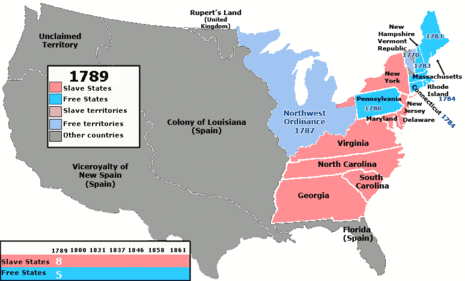Slavery in the Colonial North
The northeastern and mid-Atlantic states, including Massachusetts, New York, Pennsylvania, and New Jersey, had legally permitted slavery in the 17th and 18th centuries. However, during the decades leading up to the American Civil War, almost all slaves in the North had been emancipated through a series of state legislature statutes, creating the northern "free states" in opposition to southern "slave states."
Even though slavery was permitted, northern states characteristically had far smaller slave populations than the South. Few slave ships arrived in New York, Philadelphia, or Boston, which instead became trade centers for manufactured goods. Slaves that lived in the North were often domestic servants or bondsmen to small farmers and rural ironworks. Unlike in the South, northern farms were not large-scale enterprises that focused on producing a single cash crop; instead they were often smaller, more agriculturally diversified enterprises that required fewer laborers. Hence, the need for enslaved bondsmen gradually dwindled—especially as rapid soil depletion and the growth of industry in northern cities attracted many rural northerners to wage labor.
The Gradual Abolition of Slavery
The first U.S. region to abolish slavery was the Northwest Territory under the Northwest Ordinance of 1787. The states created from this region—Ohio, Indiana, Michigan, Illinois, Wisconsin, and Minnesota—were generally settled by New England farmers and American Revolutionary War veterans who were granted land in this area. This territory was entirely slave-free from its inception and separated by the Ohio River from the South, which was pushing for an expansion of legal slavery into the West. The concept of "free states" developed in contrast to these "slave states" by the early 19th century. After the Northwest Ordinance, Massachusetts abolished slavery in its state constitution, and several other northern states followed suit by drafting statutes that provided for gradual emancipation. In 1804, New Jersey became the last northern state to abolish slavery.
Continued Dependency on Slavery
Even though slavery was not a prevalent institution in the North, the commercial urban centers that sprang up in these colonies meant that most northerners had a vested stake in ensuring that American slavery flourished in the South. This is particularly true after the advent of the cotton gin, which supplied the North with the surplus of raw cotton necessary to produce finished goods for export. Northern industry and commerce relied on southern cash crop production; therefore, while slavery was actively abolished in the North, most northerners were content to allow slavery to flourish in the southern states. Indeed, it wasn't until later arguments over the admission and representation of states in the union and the threat of southern states overpowering their northern counterparts because of their higher slave populations, that many northerners began to oppose the expansion of southern slavery.

Free States in 1789
This map illustrates the free states in the United States in 1789, which included Pennsylvania, Connecticut, Rhode Island, Massachusetts, New Hampshire, and Maine. The Northwest Ordinance was also a free territory, though it was not yet incorporated as a state.